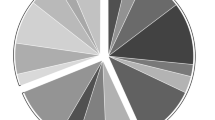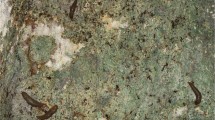Abstract
The Cyanobacterium Oculatella subterranea Zammit, Billi, Albertano inhabits hypogea and stone caves and is a pioneer of different stone substrata. In this study, a strain isolated from the House of Marco Castricio (Archaeological Park of Pompeii, Italy) was identified by a polyphasic approach and used for an in vitro colonization test to verify the influence of the substrate on the biofilm architecture. Fine structure of O. subterranea microbial mats was revealed as well as filaments orientation toward light source. This aim has been achieved through confocal laser scanner microscope microscopy and computer image analysis. Moreover, bioreceptivity of five different substrates, commonly retrieved in archaeological sites of Campania, was assessed for O. subterranea. Our results show that the three-dimensional structure of O. subterranea microbial mats is poorly affected by physical and geochemical features of substrates: in fact, the porous architecture of its biofilm was preserved, independently of the materials. On the other hand, the area/perimeter ratio relative to the O. subterranea growth on tuff, brick, and porphyry showed significant differences, indicating dissimilar levels of bioreceptivity of the three substrates.






Similar content being viewed by others
References
Adam JP (2003) L’arte di costruire presso i romani. Longanesi, Milano
Arganda-Carreras I, Kaynig V, Rueden C, Eliceiri KW, Schindelin J, Cardona A, Seung HS (2017) Trainable Weka segmentation: a machine learning tool for microscopy pixel classification. Bioinformatics 33(15):2424–2426
ASTM D4404-18 (2018) Standard test method for determination of pore volume and pore volume distribution of soil and rock by mercury intrusion porosimetry. ASTM International, West Conshohocken, PA
Baveye P (2002) Comment on “Evaluation of biofilm image thresholding methods”. Water Res 36:805–806
Beyenala H, Donovana C, Lewandowski Z, Harkin G (2004) Three-dimensional biofilm structure quantification. J Microbiol Methods 59:395–413
Bruno L, Valle V (2017) Effect of white and monochromatic lights on cyanobacteria and biofilms from roman catacombs. Int Biodeterior Biodegrad 123:286–295
Bruno L, Quici L, Ficorella I, Valentini F (2014) Nanographene oxide: a new material for a non-invasive and non-destructive strategy to remove biofilms from rock surfaces. In: Saiz-Jimenez C (ed) The conservation of subterranean cultural heritage. Taylor & Francis Group, pp 125–131
Characklis WG, McFeters GA, Marshall KC (1990) Physiological ecology in biofilm systems. In: Characklis WG, Marshall KC (eds) Biofilms. John Wiley & Sons, pp 341–394
Cnudde V, Jacobs P (2003) Preliminary results of X-ray microtomography applied in conservation and restoration of natural building stones. In: Otani J, Obara Y (eds) Proceedings of the International Workshop on X-ray CT for Geomaterials, “GeoX2003”, X-ray CT for Geomaterials, Soils, Concrete, Rocks. Kumamoto, Japan: AA Balkema, Publishers, 6–7 November, pp 363–371
Colella A, Calcaterra D, Cappelletti P, Langella A, Papa L, de Gennaro M (2009) I tufi zeolitizzati nell’architettura della Campania. In: Cuzzolin M (ed) Diagnostica per la tutela e la conservazione dei materiali nel costruito. Atti del Convegno Diacomast, Belvedere di S. Leucio (CE), 21–22 Febbraio 2008, 1:327–341
Colella A, Di Benedetto C, Calcaterra D, Cappelletti P, D’Amore M, Di Martire D, Graziano SF, Papa L, de Gennaro M, Langella A (2017) The Neapolitan Yellow Tuff: an outstanding example of heterogeneity. Constr Build Mater 136(1):361–373
Crivellari F, D’Agostino C, Fedrizzi F, Filz C, Zampedri G (2008) Catalogo ragionato, in: Atlante della pietra trentina. Antichi e nuovi percorsi, guida all’utilizzo. Camera di Commercio I.A.A. di Trento, pp 81–174
Curtis TP, Sloan WT (2004) Prokaryotic diversity and its limits: microbial community structure in nature and implications for microbial ecology. Curr Opin Microbiol 7(3):221–226
Cuzman OA, Tapete D, Fratini F, Mazzei B, Riminesi C, Tiano P (2014) Assessing and facing the biodeteriogenic presence developed in the Roman Catacombs of Santi Marco, Marcelliano e Damaso, Italy. Eur J Sci Theol 10(3):185–197
De Bonis A, Grifa C, Cultrone G, De Vita P, Langella A, Morra V (2013) Raw materials for archaeological pottery from the Campania region of Italy: a petrophysical characterization. Geoarchaeology 28:478–503
de Gennaro R, Langella A, D’Amore M, Dondi M, Colella A, Cappelletti P, de Gennaro M (2007) Use of zeolite-rich rocks and waste materials for the production of structural lightweight concretes. Appl Clay Sci 41:61–72
Doyle JJ, Doyle JL (1990) Isolation of plant DNA from fresh tissue. Focus 12:13–15
Garcia-Pichel F, Wingard CE, Castenholz RW (1993) Evidence regarding the UV sunscreen role of a mycosporine-like compound in the cyanobacterium Gloeocapsa sp. Appl Environ Microbiol 59(1):170–176
Gaylarde CC, Gaylarde PM (2005) A comparative study of the major microbial biomass of biofilms on exteriors of buildings in Europe and Latin America. Int Biodeterior Biodegrad 55(2):131–139
Gaylarde CC, Rodríguez CH, Navarro-Noya YE, Ortega-Morales BO (2012) Microbial biofilms on the sandstone monuments of the Angkor Wat complex, Cambodia. Curr Microbiol 64(2):85–92
Guillitte O (1994) Bioreceptivity: a new concept for building ecology studies. Sci Total Environ 167:215–250
Guillitte O, Dreesen R (1995) Laboratory chamber studies and petrographical analysis as bioreceptivity assessment tool of building materials. Sci Total Environ 167:365–374
Hermanowicz SW, Schindler U, Wilderer P (1996) Anisotropic morphology and fractal dimensions of biofilms. Water Res 30(3):753–755
Heydorn A, Nielsen AT, Hentzer M, Sternberg C, Givskov M, Ersbøll BK, Molin S (2000) Quantification of biofilm structures by the novel computer program COMSTAT. Microbiology 146:2395–2407
Hotaling NA, Bharti K, Kriel H, Simon CS Jr (2015) DiameterJ: a validated open source nanofiber diameter measurement tool. Biomaterials 61:327–338
Hsieh P, Pedersen JZ, Albertano P (2013) Generation of reactive oxygen species upon red light exposure of cyanobacteria from Roman hypogea. Int Biodeterior Biodegrad 84:258–265
Hutchens E (2009) Microbial selectivity on mineral surfaces: possible implications for weathering processes. Fungal Biol Rev 23(4):115–121
ISO 4287-1 (1984) Surface roughness-terminology: part 1. Surface and its parameters. International Organization for Standardization, Geneva.
Karaca Z, Öztürk A, Çolak E (2015) Biofouling of marbles by oxygenic photosynthetic microorganisms. Environ Sci Pollut Res 22:11285–11289
Ketchamand RA, Carlson WD (2001) Acquisition, optimisation and interpretation of X-ray computed tomographic imagery: applications to the geoscience. Comput Geosci UK 27(4):381–400
Kuehn M, Hausner M, Bungartz H-J, Wagner M, Wilderer PA, Wuertz S (1998) Automated confocal laser scanning microscopy and semiautomated image processing for analysis of biofilms. Appl Environ Microbiol 64(11):4115–4127
Larkin MA, Blackshields G, Brown NP, Duenna R, McGettigan PA, McWilliam H, Valentin F, Wallace IM, Wilm A, Lopez R, Thompson JD, Gibbon TJ, Higgins DG (2007) Clustal W and Clustal X version 2.0. Bioinformatics 23:2947–2948
Lepanto P, Lecumberry F, Rossello J, Kierbel A (2014) A confocal microscopy image analysis method to measure adhesion and internalization of Pseudomonas aeruginosa multicellular structures into epithelial cells. Mol Cell Probes 28(1):1–5
Liu ZQ (1991) Scale space approach to directional analysis of images. Appl Opt 30(11):1369–1373
Marasco D, Nocerino S, Pinto G, Pollio A, Troisi G, De Natale A (2016) Weathering of a roman mosaic—a biological and quantitative study on in vitro colonization of calcareous tesserae by phototrophic microorganisms. PLoS One 11(10):e0164487
Miller AZ, Dionısio A, Macedo MF (2006) Primary bioreceptivity: a comparative study of different Portuguese lithotypes. Int Biodeterior Biodegrad 57(2):136–142
Miller AZ, Leal N, Laiz L, Rogerio-Candelera MA, RJC S, Dionisio A, Macedo MF, Saiz-Jimenez C (2010) Primary bioreceptivity of limestones used in Southern Europe monuments. In: Smith BJ, Gomez-Heras M, Viles HA, Cassar J (eds) Limestone in the built environment: present day challenges for the preservation of the past. Geological Society, special publications, London, pp 79–92
Ollion J, Cochennec J, Loll F, Escudé C, Boudier T (2013) TANGO: a generic tool for high-throughput 3D image analysis for studying nuclear organization. Bioinformatics 29(14):1840–1841
Petroff AP, Sim MS, Maslov A, Krupenin M, Rothman DH, Bosak T (2010) Biophysical basis for the geometry of conical stromatolites. Proc Natl Acad Sci 107(22):9956–9961
Pivko D (2003) Natural stones in earth’s history. Acta Geologica Universitatis Comenianae, Bratislava 58:73–86
Prieto B, Silva B (2005) Estimation of the potential bioreceptivity of granitic rocks from their intrinsic properties. Int Biodeterior Biodegrad 56(4):206–215
Roy A, Tripathy P, Adhikary SP (1997) Epilithic blue-green algae/cyanobacteria from temples of India and Nepal. Presence of ultraviolet sunscreen pigments. Arch Hydrobiol Suppl 120:147–161
Salmoiraghi F (1892) Materiali naturali da costruzione. Hoepli, Milano
Schindelin J, Arganda-Carreras I, Frise E, Kaynig V, Longair M, Pietzsch T, Preibisch S, Rueden C, Saalfeld S, Schmid B, Tinevez J, White DJ, Hartenstein V, Eliceiri K, Tomancak P, Cardona A (2012) Fiji: an open-source platform for biological-image analysis. Nat Methods 9(7):676–682
Tavaré S (1986) Some probabilistic and statistical problems in the analysis of DNA sequences. In: Miura RM (ed) Some mathematical questions in biology-DNA sequence analysis. American Mathematical Society, Providence
Turick CE, Berry CJ (2016) Review of concrete biodeterioration in relation to nuclear waste. J Environ Radioact 151(1:12–21
UNI EN 13755 (2008) Metodi di prova per pietre naturali: determinazione dell’assorbimento d’acqua a pressione atmosferica. Ente Nazionale Italiano di Unificazione, Milano
UNI EN 1936 (2007) . Ente Nazionale Italiano di Unificazione, Milano
Vazquez-Nion D, Silva B, Prieto B (2018) Influence of the properties of granitic rocks on their bioreceptivity to subaerial phototrophic biofilms. Sci Total Environ 610-611(1):44–54
Verità M (2014) Technology and deterioration of vitreous mosaic tesserae. Stud Conserv 45(3):65–76
Vyas N, Sammons RL, Addison O, Dehghani H, Walmsley AD (2016) A quantitative method to measure biofilm removal efficiency from complex biomaterial surfaces using SEM and image analysis. Sci Rep 6:32694
Yang X, Beyenal H, Harkin G, Lewandowski Z (2000) Quantifying biofilm structure using image analysis. J Microbiol Methods 39(2):109–119
Zammit G, Psaila P, Albertano P (2008) An investigation into biodeterioration caused by microbial communities colonising artworks in three maltese Palaeo-Christian catacombs. In: Notea A, Shoef Y (eds) Non-destructive testing, microanalysis and preservation in the conservation of cultural and environmental heritage’ ISAS International Seminars Ltd. 9th International Conference on NDT of Art, Jerusalem Israel, 25–30 May, pp 1–10
Zammit G, Billi D, Albertano P (2012) The subaerophytic cyanobacterium Oculatella subterranea (Oscillatoriales, Cyanophyceae) gen. et sp. nov.: a cytomorphological and molecular description. Eur J Phycol 47(4):341–354
Acknowledgments
The authors are particularly grateful for the precious assistance given by Dr. Claudia Di Benedetto for the characterization of lithic substrates. The authors also thank the Archaeological Park of Pompeii and particularly Dr. De Carolis for the kind guidance and support. The authors gratefully acknowledge Benedetto De Fazio for his valuable technical support.
Author information
Authors and Affiliations
Corresponding author
Additional information
Responsible editor: Robert Duran
Electronic supplementary material
Fig. S1
Detail of the five different substrata: brick (A-D), glass paste (E-H), limestone (I-L), NYT (M-P) and porphyry Q-T). Macro photographs (A, E, I, M, Q - scale bar 1 mm), single X-ray image (B, F, J, N, R - scale bar 0.2 mm), 3D reconstruction (C, G, K, O, S - scale bar 2 μm), porosity distribution between 0-280 μm in depth (D, H, L, P, T). (PNG 10835 kb)
Table S3
(DOCX 13 kb)
Fig. S4
Amount of filament in direction between -90° and +90° on brick (A, B), NYT (C, D) and porphyry (E, F). Scale bar 50 μm (PNG 2164 kb)
Rights and permissions
About this article
Cite this article
Del Mondo, A., Pinto, G., Carbone, D.A. et al. Biofilm architecture on different substrates of an Oculatella subterranea (Cyanobacteria) strain isolated from Pompeii archaeological site (Italy). Environ Sci Pollut Res 25, 26079–26089 (2018). https://doi.org/10.1007/s11356-018-2643-5
Received:
Accepted:
Published:
Issue Date:
DOI: https://doi.org/10.1007/s11356-018-2643-5




